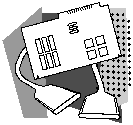|
|
Inverse Multiplexing for ATM Trunk Module
This chapter provides information on the Inverse Multiplexing for ATM Trunk Module, which is available for the StrataCom BPX AXIS shelf. The information is organized into the following sections:

http://www.cisco.com. For more information, see the chapter "Documentation" at the end of the catalog.
The Inverse Multiplexing for ATM Trunk Module enables Internet service providers, carriers, and enterprise customers to aggregate multiple T1 or E1 ATM communications links. This approach provides the benefits of ATM networking at speeds between T1/E1 and T3/E3 without the costs of broadband links.
The Inverse Multiplexing for ATM Trunk Module has the following features:
Multimedia Support for ATM Service
Cisco's multiband ATM program supports ATM wide-area links at speeds between T1/E1 and T3/E3. As part of the commitment to ATM networking, Cisco introduces the Inverse Multiplexing for ATM Trunk Module (IMATM) for StrataCom Service Nodes so that you can have immediate access to Cisco's midband ATM technology. The IMATM uses inverse multiplexing for ATM (IMA) technology to aggregate multiple T1 or E1 lines to form a single high-speed ATM link.
The IMATM and its associated back card install in a multiservice StrataCom ATM Switch Interface Shelf (AXIS). AXIS shelves work with the StrataCom BPX Service Nodes (IGX support is forthcoming). They adapt multiple types of service traffic to ATM and aggregate the traffic before feeding it into the switching core of the service node.
IMATM cards are available in a T3-to-multiple-T1 version and an E3-to-multiple-E1 version, providing trunking between BPXs at up to 8xT1 or 8xE1 speeds.
Inverse Multiplexing for ATM Trunk Modules provide a smooth migration from narrowband to broadband ATM. A BPX trunk can be configured initially to use a single T1 or E1 line. The bandwidth can then be increased by one or more lines at a time until the breakeven point for broadband tariffs is reached at about eight lines.
By providing a range of options between T1/E1 and T3/E3, a BPX Service Node can be configured to meet the traffic needs of each organization. This versatility eliminates the problem of paying for unneeded bandwidth that arises when an organization jumps directly from T1/E1 to T3/E3.
Using Inverse Multiplexing for ATM Trunk Modules in the AXIS interface shelf, StrataCom BPX Service Nodes can implement trunk bandwidths between T1/E1 and T3/E3 speeds. Interfaces on the BPX broadband shelf provide high-speed ATM connectivity for network segments with heavier traffic demands.
Cisco has designed Inverse Multiplexing for ATM Trunk Modules for fault tolerance as well as high performance.
One of the inherent advantages of IMA over other inverse multiplexing techniques is its ability to route circuits over diverse paths using different clocks with the same nominal frequency. For example, a trans-Atlantic IMA trunk could be split across two carriers---each providing its own clock---with continued operation upon if one of the carriers' circuits fails.
By its very nature, IMA technology keeps traffic flowing even when an individual circuit fails. In a non-multiplexed system, users of a given circuit might not be able to switch to a new path easily if their circuit goes out of service. In an IMA-based system, if one of the T1 or E1 links fails, all traffic on the trunk can continue to flow over the remaining links. Even though the available bandwidth is reduced, users retain their network connectivity.
In situations where reduced bandwidth is not acceptable, BPX systems with IMATM cards can be configured to show a trunk failure when a specified number of circuits fail. In this situation, the network initiates rerouting just as if the T3/E3 BNI trunk had failed. StrataCom's AutoRoute software provides support for such rerouting of traffic from IMA trunks that no longer have the capacity to handle the configured bandwidth.
Also, IMATM cards support one-for-one card redundancy through Y-cabling of the interfaces. The T1 or E1 cabling is repeated for each T1/E1 in the IMA trunk.
Cisco's midband ATM technology enables connections to take full advantage of all available bandwidth. For example, a network segment with four T1 lines multiplexed together through Inverse Multiplexing for ATM Trunk Modules can use all four lines to handle high traffic levels on a given connection.
By comparison, when multiple independent (nonmultiplexed) T1 or E1 links are used between two switches, each connection is limited to a maximum speed of T1 or E1. If a given line experiences a burst of traffic that exceeds its available bandwidth, its throughput suffers. There is no way for it to route the excess traffic to another line.
The IMATM is based on ATM cells and can support all ATM service classes and traffic types with full OptiClass support.
StrataCom's OptiClass software provides up to 16 programmable classes of service with standards-based Quality of Service (QOS) descriptors. It offers flexibility in provisioning and customizing services as well as in maintaining network efficiency.
Full resiliency is provided by supporting both 1-for-1 card redundancy and automatic adjustment of the IMA bandwidth to the number of available circuits.

Table 229 lists the product numbers you can use to order the Inverse Multiplexing for ATM Trunk Module.
Table 229 : Inverse Multiplexing for ATM Trunk Module Product Numbers
| Description | Product Numbers |
|---|---|
| IMA Trunking Module, T3 to T1s | AX-IMATM-T3-T1 |
| IMA Trunking Module, E3 to E1s | AX-IMATM-E3-E1 |
| Back card for AX-IMATM-T3-T1, RJ48 connectors | AX-RJ48-T3T1 |
| Back card for AX-IMATM-E3-E1, RJ48 connectors | AX-RJ48-E3E1 |
| Back card for AX-IMATM-E3-E1, SMB connectors | AX-SMB-E3E1 |
|
|
Copyright 1988-1996 © Cisco Systems Inc.